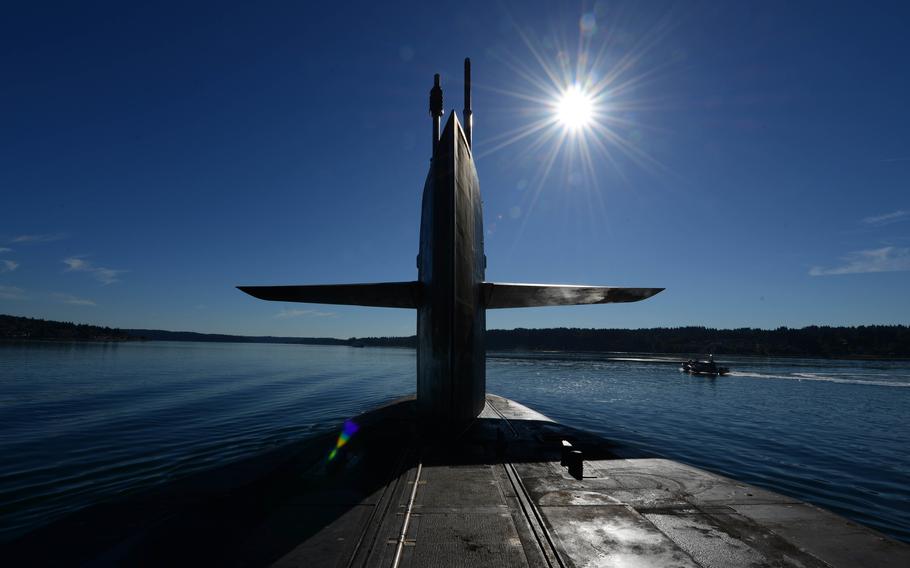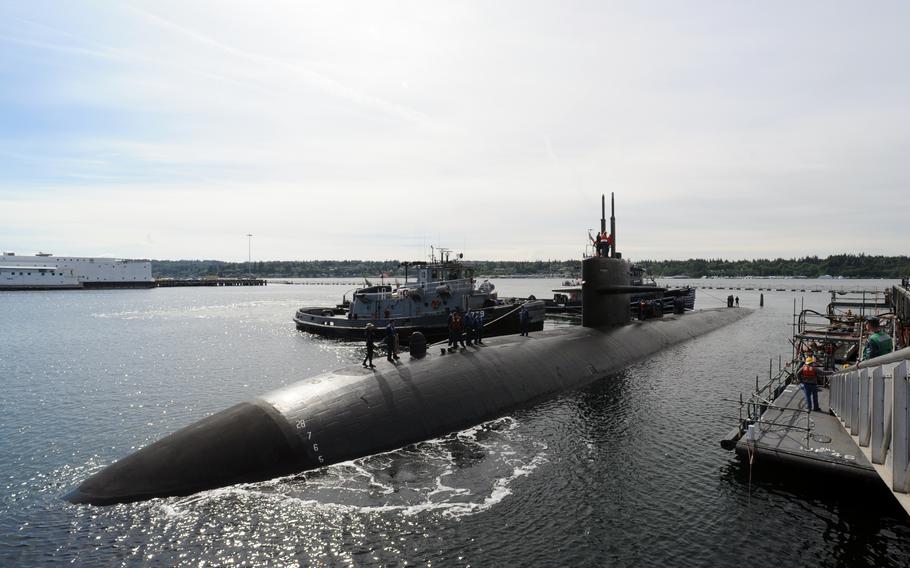
The guided-missile submarine, USS Ohio (SSGN 726), sails through the Puget Sound on June 26, 2015, after departing Puget Sound Naval Shipyard after nearly a year spent in the yards. (Kenneth G. Takada/U.S. Navy)
(Tribune News Service) — Beneath the commercial and recreational vessels and island-bound ferries that navigate Puget Sound on any given day, something else swims secretly armed with a payload sufficient to permanently reshape a continent.
Eight hulking Ohio-class nuclear submarines, each nearly as long as two football fields and armed with a spectrum of nuclear weapons, call Naval Base Kitsap at Bangor on the Kitsap Peninsula home. At any given moment, seven of them are armed with nuclear warheads and discreetly traversing the Pacific Ocean while one refuels at Bangor.
These warheads make Washington state host to the globe’s third-largest arsenal of deployed nuclear weapons — an estimated 1,120 — behind only Russia and the United States as a whole, whose stockpiles still number in the thousands, despite decades of reductions, according to the Federation of American Scientists.
One weapon in particular on those subs is at the apex of relevance in its short life: The W76-2, a reduced-payload nuclear warhead designed to counter Russia. It was rushed into production by the Trump administration and greenlighted by Congress in anticipation of a moment precisely like this one — a Russian invasion of a friendly nation, where President Vladimir Putin’s “escalate to de-escalate” doctrine could inch the world’s nuclear superpowers closer and closer to an exchange.
Bellevue’s U.S. Rep. Adam Smith, a Democrat and chairman of the House Armed Services Committee, worries that the warhead’s reduced yield would make it more tempting for a president to use. Even if the rival nations refrain from trading nuclear strikes, Smith knows well that every twitch from a nuclear superpower creates a cascade of ripples to other nuclear-armed states, and could kick-start a new arms race.
“It’s an important moment for the entire country and the entire world, including Washington state,” said Smith in an interview last week after being briefed by the Pentagon on the situation in Ukraine. “It’s a more dangerous and potentially conflicted world, and we’re all going to have to reckon with it cautiously.”
It would take many steps of escalation for Ukraine to turn into a nuclear exchange involving Russia and the U.S., according to Hans Kristensen, who closely tracks nuclear forces worldwide at the nonprofit Federation of American Scientists in Washington, D.C.
Among them: Putin using a nuclear weapon in the conflict zone, or the U.S. being drawn into active combat.
“At the outset, it would require a direct military clash of some magnitude between Russia and NATO,” Kristensen said. “I don’t think there’s a snowball’s chance in hell that nuclear weapons would come into play in Ukraine. That’s crazy, even for Putin.”
Putin wasted no time escalating nuclear rhetoric after his military began its invasion of Ukraine just over two weeks ago, moving his arsenal to high alert on the fourth day.
As Russia’s attack met unexpectedly stiff resistance, U.S. intelligence officials noted that Russian military strategy favors escalating conflicts as a means of controlling them, particularly when conventional forces are overwhelmed.
To stave off any gains that advantage Ukraine, Putin has bracketed the conflict with political red lines that threaten to tip the nuclear balance: No NATO combatants, no no-fly zone and no aerial intervention from neighboring states.
The U.S. opted not to follow Russia’s lead and did not elevate the alert status of its nuclear weapons. The Pentagon also canceled a scheduled test launch of an intercontinental ballistic missile days after Putin’s announcement.
That has fostered optimism among some nuclear scholars and key members of Congress that Russia and the United States will keep their nukes holstered.
“Let me reassure the public: I do not think we are on the brink of a nuclear conflict,” Smith said. “Putin is not suicidal.”
A new weapon
In January 2020, life on the Olympic Peninsula carried on normally. Spectators were treated to an underground tour of Port Angeles, patrons swarmed community art shows and seats at casinos were full. Patches of dry weather provided hikers forest refuge from the long Pacific Northwest winter.

The Los Angeles-class attack submarine USS Bremerton (SSN 698) returns to its namesake at Naval Base Kitsap’s Pier Delta on May 25, 2012. (Lawrence James Davis III/U.S. Navy)
But in the waters off the Kitsap Peninsula, an important shift between nuclear-armed nations was taking shape. That month, the U.S. armed its nuclear attack subs with the new W76-2 warhead, a fresh addition to the inventory that would change decision-making processes about the nuclear strategies of Washington, Moscow, Beijing and Pyongyang, North Korea.
The new small-scale nuke was strapped on missiles in subs alongside its high-yield, city-busting cohorts, the W76-1 and W88. Subs based at Bangor troll the Pacific armed with a mix of 630 nuclear warheads, while 490 more sit in storage in the Strategic Weapons Facility located next to the submarine base.
The W76-2 warhead was born on paper in February 2018, on page 18 of former President Donald Trump’s 100-page unclassified Nuclear Posture Review. It also called for a new nuclear warhead for sea-launched cruise missiles on Navy ships. New presidents have been conducting these studies for a quarter century to adjust U.S. nuclear doctrine for changing times and to reflect their priorities.
The U.S. at the time had barely waded into its most ambitious update to the nuclear arsenal since the Cold War, a planned 30-year, $2 trillion refresh.
Although the modernization campaign began under the Obama administration, Trump’s review strayed dramatically from the four presidents who preceded him. The Center for Strategic and International Studies, a defense-oriented Washington, D.C., think tank, noted at the time of the posture review’s release that it “appears to place increasing emphasis on nuclear weapons as an instrument of national power.”
Instead of minimizing nuclear weapons, it emphasized them, even as significant arms-control accords between the U.S. and Russia crumbled. In 2019, the U.S.‘ count of nuclear warheads saw its first year-over-year growth since 1996, according to the U.S. State Department.
Trump’s most ambitious nuclear decision was creation of the W76-2 warhead, carried primarily on subs based at Bangor, which cover the Pacific Ocean, and Kings Bay, Georgia, whose Atlantic fleet covers the current conflict zone in Ukraine.
Despite objections in Congress, primarily from Democrats, and arms control experts, the warhead was rushed into production in just 14 months and for a total of $94.6 million, according to the Congressional Research Service. Both figures constitute marvels of efficiency from the production network of private contractors.
But at what cost to nuclear stability, critics ask? “There is no such thing as a ‘tactical’ nuclear weapon,” Smith said, referring to the alternate name for low-yield warheads.
“In this era when we know exactly what nuclear weapons are, and we have nuclear weapons five, 10, 20 times more potent than we had in World War II, introducing the idea of tactical nuclear weapons is dangerous. It will not be manageable. Once a nuclear weapon is used, we cannot promise our response will be proportional.”
Proponents of the W76-2 point to the Cold War as evidence that the U.S. can show restraint with nuclear weapons, even when their capabilities are vast, according to the Congressional Research Service.
‘Escalate to de-escalate’
This is precisely the moment the W76-2 warhead’s critics and proponents pondered as it was debated. The warhead was created to counter Russia, which relies heavily on tactical, or low-yield, nuclear weapons.
“The W76-2 was sold to Congress and the public on precisely these kinds of scenarios,” Kristensen said. “It was sold as a strategic, prompt response to an early first use of a tactical weapon. But it could be applied to any use.” Trump’s Nuclear Posture Review mentions Russia by name as the adversary driving the U.S. to add the new warhead.
The W76-2 packs a yield about one-third to one-half that of the bombs dropped on Hiroshima and Nagasaki, and is not designed to be a city-destroyer, like some of its counterparts also in missiles silos, on planes and on the Bangor-based subs. Instead, its utility in the conflict in Ukraine is to respond if Russia uses a small nuke first.
It’s a realistic scenario based on what U.S. intelligence knows about Moscow’s nuclear doctrine, described as “escalate to de-escalate.”
“ Russia may also rely on threats of limited nuclear first use, or actual first use, to coerce us, our allies, and partners into terminating a conflict on terms favorable to Russia,” according to the 2018 Nuclear Posture Review. Based on Putin’s doctrine, Pentagon leaders worry Russia could resort to using nuclear weapons, especially the low-yield variety, if its conventional forces fall behind in the fight.
“Potential adversaries, like Russia, believe that employment of low-yield nuclear weapons will give them an advantage over the United States and its allies and partners,” John Rood, Trump’s undersecretary of defense for policy, said in February 2020. The warhead provides the U.S. a quick-response option if Russia uses a nuclear weapon first, and reassures allies protected by the U.S. nuclear umbrella that they’re well-protected by the U.S. arsenal.
A new arms race?
But there’s concern from critics of the W76-2, including Smith, that its utility in responding to a limited nuclear strike would quickly escalate into full-blown nuclear war, killing up to 100 million people across the globe almost immediately, according to some estimates, and setting the stage for widespread famine and displacement that could kill countless more.
Already, there are signs policymakers are pushing greater reliance on nuclear weapons. On Tuesday, Adm. Chas Richard, head of U.S. Strategic Command, which oversees the military side of the U.S. nuclear weapons program, testified before the Senate Armed Services Committee about Russian and Chinese nuclear forces.
“We do not know the endpoints of where either of those other two are going, either in capability or capacity,” he said. But he took the opportunity to endorse a controversial update of U.S. intercontinental ballistic missiles that the Congressional Budget Office estimates would cost $82 billion.
Immediately following Richard’s testimony, Sen. Jim Inhofe, R- Okla., an outspoken supporter of the W76-2, tweeted: “The time has come to look at what additional nuclear capabilities we need before China and Russia leave us behind.”
With Trump’s proposed sea-launched cruise missile still up for debate in Congress, it remains to be seen whether Bangor might soon host another new nuclear weapon that upends existing nuclear strategy around the world.
___
(c)2022 The Seattle Times
Visit The Seattle Times at www.seattletimes.com
Distributed by Tribune Content Agency, LLC.